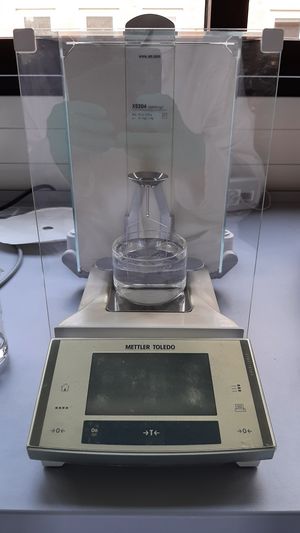Archimedes density
The Archmiedes method uses the buoyancy of a ceramic specimen in water to measure its volume. The open and closed porosity can be evaluated separately. The method is very simple and requires only a high-precision scale with a suitable frame (see pictures) and a beaker with water.
First, the dry mass of the specimen is evaluated. Subsequently, the specimen should be infiltrated with water (use another liquid for hygroscopic samples) in vacuum to assure that open pores are filled with water. This step can be omitted if the open porosity is negligible.
Second, the buoyant mass of the specimen is evaluated. The sample is placed on a mesh or grid on the weighting frame of the scale that is placed within a beaker with water. Make sure that:
- The water is equilibrated, i.e. reached room temperature and had enough time to reach equilibrium gas concentrations
- The beaker does not touch the weighting grid or plate anywhere
- The mesh/grid including specimen is completely submerged and does not touch the beaker anywhere
- During handling, no drop of water is spilled anywhere on the frame or plate of the scale
Third (optional), the specimen is cleaned at the surface with a wet cloth such that no drops of water remain at the surface, but no water is removed from the open porosity (i.e. do not use a dry cloth!). The specimen is weighted again outside of water.
From these three masses, the density of the specimen is obtained by:
\delta_closed=m_dry*(\delta_H2O/(m_wet - m_buoyant)
\delta_all=m_dry*(\delta_H2O/(m_dry - m_buoyant)
For optimum results, the temperature of the water needs to be corrected for the temperature, e.g. according to this table: https://www.internetchemie.info/chemie-lexikon/daten/w/wasser-dichtetabelle.php




